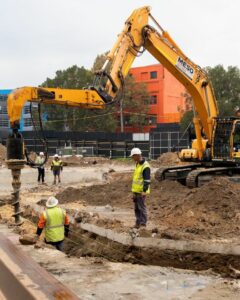Why Heavy Machinery Maintenance is Essential

The Ultimate Guide to Heavy Machinery Maintenance for Construction Efficiency
Heavy machinery is the backbone of the construction industry, ensuring efficiency and productivity in every project. However, maintaining these machines is crucial to prevent breakdowns, reduce costs, and extend their lifespan. In this comprehensive guide, we will explore essential heavy machinery maintenance tips, best practices, and how proper maintenance can enhance operational efficiency.
Why Heavy Machinery Maintenance is Essential
Proper maintenance of heavy equipment provides numerous benefits, including:
- Extended Equipment Lifespan – Regular servicing helps machinery last longer and perform optimally.
- Improved Safety – Well-maintained equipment reduces the risk of workplace accidents.
- Cost Savings – Preventative maintenance prevents costly repairs and replacements.
- Higher Efficiency – Machines that run smoothly contribute to project timelines and profitability.
Types of Heavy Machinery Used in Construction
Understanding the different types of machinery in construction helps in implementing the correct maintenance practices. Common types include:
- Excavators – Used for digging and material handling.
- Bulldozers – Ideal for pushing large quantities of material.
- Cranes – Essential for lifting and moving heavy loads.
- Loaders – Used for transporting materials around sites.
- Backhoes – Multi-purpose equipment for excavation and trenching.
- Graders – Used for leveling surfaces before paving.
Each type of machine requires specific maintenance routines to function efficiently.
Preventative Maintenance Strategies
1. Regular Equipment Inspections
Routine inspections help detect potential issues before they lead to breakdowns. Key aspects to check include:
- Hydraulic systems for leaks
- Engine performance and fuel efficiency
- Tire and track condition
- Brake system functionality
- Electrical components and wiring
Pro Tip: Keep a maintenance log for each machine to track inspections and repairs.
2. Lubrication and Fluid Management
Lubrication reduces friction and prevents wear and tear. Regularly check and replace:
- Engine oil
- Hydraulic fluid
- Transmission fluid
- Coolants
Using high-quality lubricants suited for specific machinery enhances performance.
3. Clean Machinery After Use
Dirt, mud, and debris can cause blockages and reduce efficiency. Washing machines and clearing dirt from moving parts prevent:
- Corrosion and rust formation
- Clogging of filters and ventilation systems
- Overheating due to poor air circulation
4. Proper Storage and Protection
Protecting equipment from harsh weather conditions extends its lifespan. Store machinery in covered or climate-controlled areas to:
- Prevent rust and corrosion
- Protect electrical components
- Reduce exposure to extreme temperatures
5. Train Operators on Best Practices
Well-trained operators use equipment efficiently and reduce unnecessary wear. Training should include:
- Safe operation techniques
- Identifying early signs of mechanical issues
- Proper load management
- Shutdown and startup procedures

Explore top-quality used crawler cranes for sale at CraneKart. Reliable, affordable, and ready for your next project.
Common Heavy Machinery Issues and How to Fix Them
1. Engine Overheating
- Causes: Low coolant levels, clogged radiators, faulty water pumps.
- Solutions: Regularly check coolant levels, clean radiators, replace faulty components.
2. Hydraulic Failures
- Causes: Contaminated hydraulic fluid, damaged hoses, worn-out seals.
- Solutions: Use clean hydraulic fluid, inspect hoses for leaks, replace worn seals promptly.
3. Electrical Malfunctions
- Causes: Loose wiring, corroded battery terminals, sensor failures.
- Solutions: Inspect and tighten electrical connections, clean battery terminals, test and replace faulty sensors.
4. Track and Tire Wear
- Causes: Excessive loads, uneven terrain, lack of alignment.
- Solutions: Maintain proper tire pressure, rotate tracks regularly, avoid rough terrain when possible.
Best Practices for Long-Term Equipment Care

To ensure your heavy machinery operates optimally, implement these best practices:
- Follow Manufacturer’s Maintenance Schedules – Always adhere to OEM (Original Equipment Manufacturer) guidelines.
- Use Genuine Replacement Parts – Using non-OEM parts may reduce performance and longevity.
- Monitor Fuel Quality – Contaminated fuel can damage engines and decrease efficiency.
- Keep Spare Parts Handy – Having essential spare parts on-site minimizes downtime.
- Implement Digital Maintenance Tracking – Use fleet management software to track maintenance schedules and alerts.
Leveraging Technology for Equipment Maintenance
Modern technology enhances maintenance practices, making it easier to track, predict, and manage equipment health. Some useful innovations include:
- IoT Sensors: Detect performance issues and send real-time alerts.
- AI-Based Predictive Maintenance: Identifies wear and tear patterns before failures occur.
- GPS Tracking: Monitors equipment location and usage hours.
- Cloud-Based Maintenance Logs: Keeps records accessible from anywhere.
Conclusion
Effective heavy machinery maintenance is key to ensuring safety, efficiency, and cost-effectiveness in construction projects. By following preventative strategies, training operators, and leveraging modern technology, you can maximize the lifespan and productivity of your equipment.
For high-quality construction machinery and maintenance solutions, visit CraneKart today!
